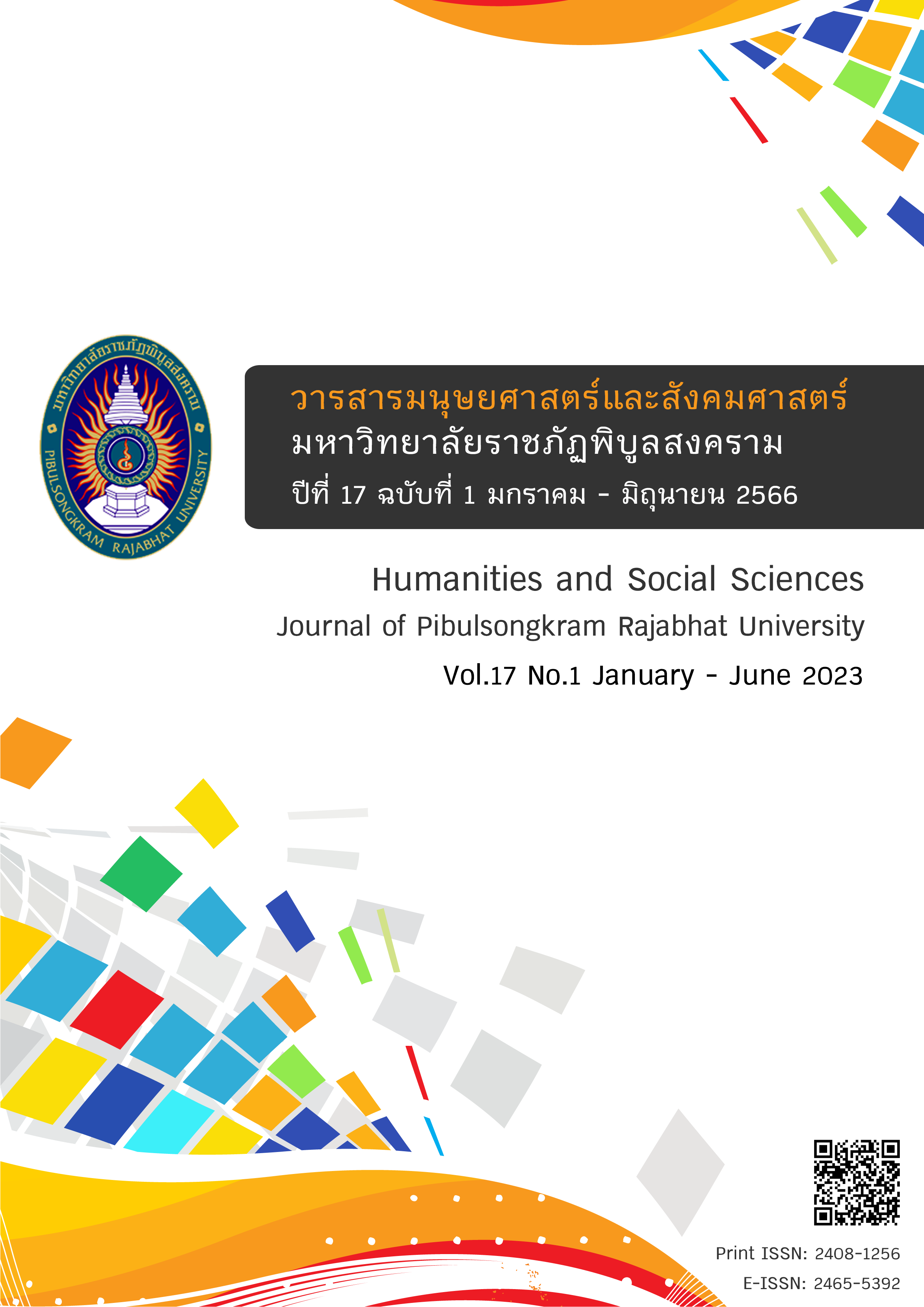Learning teachers management behaviors in different contexts
DOI:
https://doi.org/10.14456/psruhss.2023.16Keywords:
Learning teachers management behaviors, Washback, Different contextsAbstract
Washback is the effect of testing on teaching and learning of teachers and students that can be considered either positive or negative. Washback of teachers among different contexts. The objective of this research was to study learning teachers management behaviors in different contexts. Classified by context: School size, reputation, Assessment-Based Instruction and compare the differences of washback of teachers among different contexts. The sample consisted of 192 teachers and were obtain by multi-stage random sampling. Data were collected using a survey questionnaire. The survey data were analyzed using mean and standard deviation, coefficient of variation (CV), Skewness, Kurtosis and MANOVA. The survey results revealed that the teaching teachers in different contexts, prestigious schools, and non-prestigious schools showed the positive and negative washback at a high level. Teachers used assessment-based instruction at low level. Meanwhile, the teaching behaviors showed the positive and negative washback at the highest level. Teachers used assessment-based instruction at medium level, while the positive and negative washback was at a high level. Besides, teachers used assessment-based instruction at high level, while positive and negative washback was at medium level. The results of the tests differed from teachers, group variables in different contexts were found evidence of the washback phenomenon showed that teachers engaged in teaching behavior in both positive and negative washback are different with at the .05 significant level.
References
ญาณิกา ลุนราศรี. (2557b). ผลกระทบของการทดสอบทางการศึกษาระดับชาติขั้นพื้นฐานที่มีต่อการเรียนการสอนภาษาอังกฤษในชั้นมัธยมศึกษาปีที่ 3. (วิทยานิพนธ์ปริญญามหาบัณฑิต), จุฬาลงกรณ์มหาวิทยาลัย.
ปาริฉัตร ปิติสุทธิ. (2558). ผลของการสอบระดับชาติที่มีต่อครูและนักเรียน: การวิเคราะห์ปรากฏการณ์วอชแบค. (วิทยานิพนธ์ปริญญามหาบัณฑิต), จุฬาลงกรณ์มหาวิทยาลัย.
วราภรณ์ แย้มทิม. (2556). การจัดการเรียนรู้โดยใช้การประเมินเป็นฐาน. ใน สุวิมล ว่องวาณิช และคณะ (2556, 35-47) คู่มือปฏิบัติการครูในการประเมินสู่การเรียนการสอน สำนักงานกองทุนสนับสนุนการวิจัย (สกว.). กรุงเทพฯ: บริษัท พริกหวานกราฟฟิค จำกัด.
วันดี สมมิตร. (2552). ผลกระทบของการสอบระดับชาติขั้นพื้นฐานที่มีต่อพฤติกรรมการสอนของครูในเขตกรุงเทพมหานคร: การวิจัยแบบผสม. (วิทยานิพนธ์ปริญญามหาบัณฑิต), จุฬาลงกรณ์มหาวิทยาลัย.
วิษณุ ทรัพย์สมบัติ. (2563). ผลการทดสอบO-NET ปีการศึกษา 2662. Retrieved from https://www.facebook.com/AkeAkin.
สถาบันทดสอบทางการศึกษาแห่งชาติ. (2563). การทดสอบทางการศึกษาระดับชาติ. [ออนไลน์]. แหล่งที่มา http://www.niet.or.th. [2563, มีนาคม 12].
สำนักงานปลัดกระทรวงศึกษาธิการ สำนักนโยบายและยุทธศาสตร์. (2562). แผนปฏิบัติราชการประจำปีงบประมาณ พ.ศ. 2561 ของสำนักงานปลัดกระทรวงศึกษาธิการ (ฉบับปรับปรุงตามงบประมาณที่ได้รับจัดสรร). กรุงเทพฯ: ม.ป.ท.
สำนักประสานและพัฒนาการจัดการศึกษาท้องถิ่น กรมส่งเสริมการปกครองท้องถิ่น กระทรวงมหาดไทย. (2563). แนวทางการเสริมสร้างความพร้อมในการจัดการศึกษาขององค์กรปกครองส่วนท้องถิ่น. กรุงเทพฯ: กรมส่งเสริมการปกครองท้องถิ่น กระทรวงมหาดไทย.
สุวิมล ว่องวาณิช. (2556). แนวคิดการปฏิบัติงานของครู. ใน สุวิมล ว่องวาณิช และคณะ (2556, 9-24) คู่มือปฏิบัติการครูในการประเมินสู่การเรียนการสอน สำนักงานกองทุนสนับสนุน การวิจัย (สกว.). กรุงเทพฯ: บริษัท พริกหวานกราฟิค จำกัด.
อุทุมพร จามรมาน. (2553). เอกสารบรรยาย รูปแบบข้อสอบของ สทศ.. 5 ปี สทศ.
Ahmad, S., & Rao, C. (2012). Examination Washback Effect: Syllabus, Teaching Methodology and the Learners’ Communicative Competence. Journal of Education and Practice, 3(15), 173-183.
Alderson, J. C., & Wall, D. (1993). Does washback exist? Applied linguistics, 14(2), 115- 129.
Cheng, L., & Curtis, A. (2004). Washback or backwash: A review of the impact of testing on teaching and learning. Washback in language testing: Research contexts and methods, 3-17.
David, C.C. (2008). Teachers’ Perspective on the Unintended Consequenes of High Stakes Testing. Louisiana State University. LA.
Ghorbani, M. R., & Neissari, M. (2015). Washback Effect of the Iranian Concours on Senior High School Students' EFL Learning Activities. Iranian Journal of Language Testing, 5(1), 1-28.
Hamilton, S. (2010). Assessment-based instruction. The Free Library 01 October 2010. Retrieved from http://www.thefreelibrary.com/Assessment-based instruction.a0253536855.
Manjarres, N. B. (2005). Washback of the foreign language test of the state examinations in Colombia: A case study. Arizona Working Papers in SLAT, 12, 1-19.
Messick, S. (1996). Validity and washback in language testing. ETS Research Report Series, 1996(1), i-18.
Oberg, C. (n.d.). Guiding Classroom Instruction Through Performance Assessment. Retrieved from http://www.aabri.com/manuscripts/09257.pdf.
Saif, S. (2006). Aiming for positive washback: A case study of international teaching assistants. Language testing, 23(1), 1-34.
Shih, C.-M. (2010). The washback of the General English Proficiency Test on university policies: A Taiwan case study. Language Assessment Quarterly, 7(3), 234-254.
Spratt, M. (2005). Washback and the classroom: The implications for teaching and learning of studies of washback from exams. Language Teaching Research, 9(1), 5-29.
Watanabe, Y. (2004). Methodology in washback studies Washback in language testing: Research contexts and methods (pp. 19-36). NJ: Lawrence Erlbaum Associates.
Wilson, A. T. (2009). Assessment-based instruction applied to a course and lab in digital signal processing. Paper presented at the ASEE Southeast Section Conference.
Downloads
Published
How to Cite
Issue
Section
License
Copyright (c) 2022 Humanities and Social Sciences Journal of Pibulsongkram Rajabhat University

This work is licensed under a Creative Commons Attribution-NonCommercial-NoDerivatives 4.0 International License.
Any articles or comments appearing in the Journal of Humanities and Social Sciences, Rajabhat Phibulsongkram University, are the intellectual property of the authors, and do not necessarily reflect the views of the editorial board. Published articles are copyrighted by the Journal of Humanities and Social Sciences, Rajabhat Phibulsongkram University.









